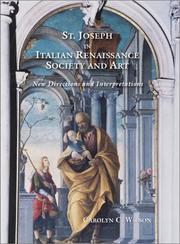| Listing 1 - 3 of 3 |
Sort by
|
Book
ISBN: 9782980633959 298063395X Year: 2001 Publisher: Montréal: Roland Gauthier,
Abstract | Keywords | Export | Availability | Bookmark
 Loading...
Loading...Choose an application
- Reference Manager
- EndNote
- RefWorks (Direct export to RefWorks)

ISBN: 0916101363 9780916101367 Year: 2001 Publisher: Philadelphia, Pa Saint Joseph's University Press
Abstract | Keywords | Export | Availability | Bookmark
 Loading...
Loading...Choose an application
- Reference Manager
- EndNote
- RefWorks (Direct export to RefWorks)
Renaissance --- iconography --- Iconography --- Christianity: persons --- anno 1400-1499 --- anno 1500-1599 --- Italy --- Art, Italian --- Art, Renaissance --- Christian saints in art --- Themes, motives --- Joseph, --- Art --- 232.932 --- 7.046 <45> --- Jozef. Jozefologie --- Iconografie: mythologische-, religieuze-, epische voorstellingen. Legenden--Italië --- 7.046 <45> Iconografie: mythologische-, religieuze-, epische voorstellingen. Legenden--Italië --- 232.932 Jozef. Jozefologie --- Renaissance art --- Giuseppe, --- José, --- Józef, --- Yūsuf, --- Art. --- Art, Italian - Themes, motives --- Art, Renaissance - Italy - Themes, motives --- Iconographie --- Ioseph sponsus B.M.V. --- Joseph, - Saint - Art --- Joseph, - Saint
Book
ISBN: 0691214077 Year: 2001 Publisher: Princeton, N.J. : Baltimore, Md. : Princeton University Press, Project MUSE,
Abstract | Keywords | Export | Availability | Bookmark
 Loading...
Loading...Choose an application
- Reference Manager
- EndNote
- RefWorks (Direct export to RefWorks)
Until now political scientists have devoted little attention to the origins of American bureaucracy and the relationship between bureaucratic and interest group politics. In this pioneering book, Daniel Carpenter contributes to our understanding of institutions by presenting a unified study of bureaucratic autonomy in democratic regimes. He focuses on the emergence of bureaucratic policy innovation in the United States during the Progressive Era, asking why the Post Office Department and the Department of Agriculture became politically independent authors of new policy and why the Interior Department did not. To explain these developments, Carpenter offers a new theory of bureaucratic autonomy grounded in organization theory, rational choice models, and network concepts. According to the author, bureaucracies with unique goals achieve autonomy when their middle-level officials establish reputations among diverse coalitions for effectively providing unique services. These coalitions enable agencies to resist political control and make it costly for politicians to ignore the agencies' ideas. Carpenter assesses his argument through a highly innovative combination of historical narratives, statistical analyses, counterfactuals, and carefully structured policy comparisons. Along the way, he reinterprets the rise of national food and drug regulation, Comstockery and the Progressive anti-vice movement, the emergence of American conservation policy, the ascent of the farm lobby, the creation of postal savings banks and free rural mail delivery, and even the congressional Cannon Revolt of 1910.
Political planning --- Government executives --- Bureaucracy --- Executive departments --- History. --- History. --- History. --- History. --- United States. --- History. --- United States. --- Arnold, R. Douglas. --- Bigelow, Willard. --- Brand, Charles. --- Cockrell Committee. --- Dahl, Robert. --- Devine, Edward. --- Estabrook, Leon. --- Farm Bloc. --- Fulton, Charles. --- Gary, James. --- Goff, H. --- Grosh, Aaron. --- Hall, B. M. --- Hays, Will. --- Hedges, Florence. --- Howard, Robert. --- Innis, Squire. --- Jardine, William. --- Johnson, Ronald. --- Katznelson, Ira. --- Kenyon, William. --- Knights of Labor. --- Lauman, George. --- Louisiana Lottery. --- Mayhew, David. --- McCraw, Thomas. --- Noble, Edwin. --- Scott, Roy. --- administrative learning. --- bank war. --- ecological control. --- narrative panel. --- organizational capacity. --- packing regulation.
| Listing 1 - 3 of 3 |
Sort by
|

 Search
Search Feedback
Feedback About UniCat
About UniCat  Help
Help News
News